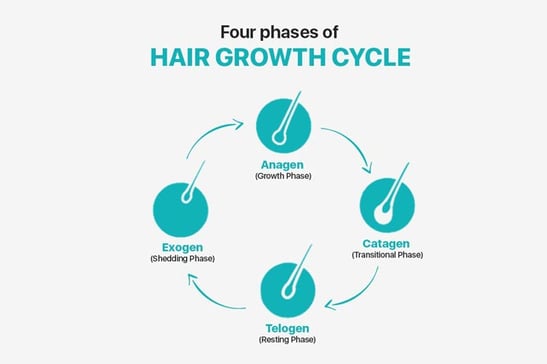In the 20 or so years since laser hair removal technology was introduced, little is new about the time it takes for laser hair removal. The greatest advancements in technology have been in the devices that now make the procedures more comfortable and faster for people with fair to dark skin. Yet, the results are still measured over months, to years.
The time to complete a full series of laser hair removal sessions varies from person to person and the location of the hair on the body, but it’s typically 12-24 months.
Why does it take so long?
It’s the hair, mate! The hair on our body grows at different rates and are in different stage of growth at any one time. For laser hair removal to be successful, the laser must destroy its target (the hair follicle) at the right time without causing any thermal damage to the surrounding tissue.
There are four phases of growth every hair on our body goes through. Anagen (active growth stage) is when the hair is most visible above the skin. Catagen (short transitional phase) the hair shaft sheds and separates from the papilla, (a nipple-like protrusion at the base of the hair follicle). Telogen (resting phase) the hair is released and falls off; growth stops and the entire structure rests. Exogen (new hair phase) is part of the resting phase where the old hair sheds and a new hair continues to grow.

All four phases occur concurrently and consecutively, yet each phase has its own timeline which can be affected by a variety of factors.
- A person’s genes will dictate how quickly their hair will grow, and the hair’s thickness and texture.
- Some follicles stop working altogether as people get older.
- Male hair grows faster than female hair.
Only hair in the active growth phase (anagen) can be treated. So, when the melanin (pigment) in hair follicle is at its darkest, it is the most susceptible to destruction by laser, preventing any further growth.
How laser hair removal works.
The laser targets the pigment (melanin) without disrupting the surrounding skin. The melanin absorbs the light. The energy from the light converts to heat and travels through the hair shaft into the hair bulb. The heat destroys and kills the papilla, cutting off the food supply to the hair bulb so that the hair doesn’t grow back. In 10 to 14 days, what’s left of the remaining hair will be expelled from the follicle and fall off.
At the right intervals, each treatment reduces the amount of hair by about 25 to 30%. With each treatment, you’ll see fewer, thinner, lighter, slower re-growth of hairs, temporary hair loss or permanent hair reduction in the treatment area.
Importance of treatment intervals.
Since each individual hair is at a different point in the cycle than the neighboring hairs, multiple treatments are needed. For some locations on the body (arms, face, mid-brow, etc.), the anagen phase may last about 30-45 days, and longer in other areas.
Successful hair removal practitioners typically follow these rule of thumb formulas.
- Hair from the neck up and the face: 4 – 6 weeks between treatments. Facial hair has significantly more hair follicles per square centimeter than the body. This is why you can see results within the first three to four treatments with shorter intervals times.
- Body hair from the neck to the groin, but not the back: 6-8 weeks between treatments.
- Back or leg hair: 8-10 weeks between treatment intervals.
It’s important to keep to the schedule of treatments, or more treatments will be needed. Treatments spaced too close together may look more successful within the first few treatments, but a smaller percentage of anagen hair may be available to target, requiring more treatments to reach the desired outcome. Other factors can also affect the treatment outcome include hormones, diseases, or medication.
Summary.
While laser hair removal technology has improved the comfort, speed, and efficacy of hair removal (reduction), the time that it takes for the hair to be gone is based in biology. Depending on how quickly your hair moves through the growth cycles and how committed to the removal process you are(not missing your intended treatment interval), you could see a permanent reduction of hair in the treatment areas of upwards to 90% within a years’ time. Annual touch ups are recommended to maintain your investment and to continue enjoying smooth touchable skin!
Have any questions about laser hair removal, want more information or to schedule a free consultation, click the link below.
 Google Reviews
Google Reviews



